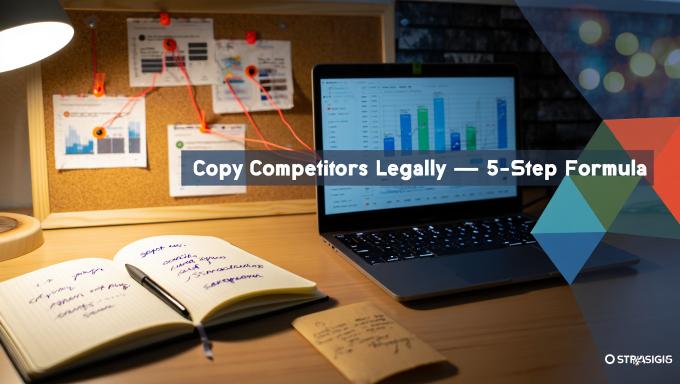If you’ve ever looked at a competitor’s post, ad, or sales page and thought, “Damn, I wish I wrote that,” — this guide is for you.
Because here’s the truth most creators and solopreneurs don’t realize:
👉 You don’t need to “steal” your competitors’ ideas — you just need to reverse-engineer what’s working and rebuild it better, faster, and sharper.
In 2025, content and copywriting aren’t about originality — they’re about pattern mastery. Every viral hook, every high-performing ad, every email that converts like crazy follows the same predictable formulas.
Let’s break down exactly how to copy your competitors legally — and turn their success into your growth engine.
🧩 Step 1: Understand What “Copying Legally” Actually Means
Copying legally isn’t plagiarism — it’s strategic benchmarking.
You’re not lifting words or visuals. You’re studying the psychology behind them:
- What emotion does their headline trigger?
- What pain points do they highlight first?
- How do they transition from problem → desire → solution?
- What’s their CTA (Call-to-Action) rhythm?
The goal is to deconstruct their winning system, not duplicate their surface-level execution.
🔍 Step 2: Collect and Organize Competitor Copy
Start by curating your “Swipe Vault” — a private document or Notion board where you collect standout examples.
Here’s what to look for:
- Ads with unusually high engagement
- Headlines that repeat across multiple brands
- Sales pages that clearly outperform others
- Social media posts with high comment ratios
Every piece of copy you save becomes data — a pattern to analyze, not to plagiarize.
🧠 Step 3: Analyze Their Copy Using AI
This is where most people stop at “inspiration” — but pros go deeper.
With AI tools like ChatGPT, you can legally and intelligently analyze competitor copy to extract its hidden structure and emotional triggers.
Use the following ChatGPT prompt to reverse-engineer any piece of content and create superior alternatives 👇
💬 ChatGPT Prompt: Copy Your Competitors Legally (Using a Proven 5-Step Formula)
ROLE:
You are an expert copywriting strategist analyzing competitor content to craft superior, higher-converting alternatives.
TASK:
Analyze the competitor’s copy and produce 3 improved versions that outperform it in engagement, clarity, and persuasion.
COMPETITOR COPY:
(credit: @sifuyik)
[Paste competitor’s copy here]
🔍 ANALYSIS REQUIREMENTS
- Hook Strength (1–10): Rate and explain why.
- Pain Points: List emotional triggers or core problems addressed.
- Value Proposition: Identify the main promise or unique benefit.
- Call-to-Action (CTA): Evaluate clarity, urgency, and persuasiveness.
- Weaknesses: Note any gaps, vague wording, or missed opportunities.
✍️ REWRITE INSTRUCTIONS
Create 3 alternative versions that:
- Use stronger, more specific hooks
- Address deeper emotional pain points
- Present clearer benefits with tangible examples or outcomes
- Include social proof or credibility cues
- End with action-focused CTAs that drive clicks or conversions
🧠 FORMATS TO PRODUCE
Version A: Emotional / Story-driven
Focus on storytelling, empathy, and transformation.
Version B: Data / Logic-driven
Use statistics, facts, and rational persuasion.
Version C: Urgency / FOMO-driven
Create time-sensitive motivation and scarcity appeal.
⚡ FINAL GUIDELINES
- Keep a similar length and platform tone as the original copy.
- Use power words and numbers/results strategically.
- Make it instantly shareable and scroll-stopping.
🧩 Step 4: Rebuild With Your Unique Angle
Now that you’ve decoded what’s working — it’s time to outperform it.
That means infusing your voice, story, and values into the structure you’ve studied.
Ask yourself:
- Can I make the pain point feel more personal?
- Can I add proof (data, testimonials, or examples) they missed?
- Can I simplify the flow to make it more emotionally sticky?
Legal copying is all about creative evolution, not duplication. You’re taking inspiration, optimizing the message, and making it unmistakably yours.
🚀 Step 5: Test, Track, and Iterate
Once you publish your improved version — track what happens.
- Which hook performs best?
- What part of the message gets saved or shared most?
- Are people commenting or DM’ing you about it?
Copywriting isn’t a one-time craft — it’s a living system. The more you test and refine, the faster you identify patterns that drive real results.
⚖️ Legal Copying ≠ Plagiarism — It’s Pattern Intelligence
Let’s be clear: copying your competitors illegally will destroy your credibility.
But learning their structure, rhythm, and psychology?
That’s copywriting mastery.
It’s the same thing musicians do when they study their favorite artists’ melodies — or athletes do when they watch game tapes of their rivals.
You’re not stealing.
You’re strategizing smarter.
✅ Key Takeaways
- Collect: Build your competitor swipe vault.
- Analyze: Use the AI prompt above to decode their strategy.
- Rebuild: Infuse your voice and better proof.
- Test: Measure engagement, conversions, and emotional response.
The next time you see a competitor post that blows up — don’t envy it.
Reverse-engineer it.
Then build something even stronger.
💬 Bonus: Quick Version of the Prompt
For daily use or quick content breakdowns 👇
Prompt (1-Paragraph Version):
You are an expert copywriting strategist. Analyze the competitor’s copy below and create 3 superior alternatives. Evaluate its hook strength (1–10), pain points, value proposition, CTA, and weaknesses. Then rewrite 3 new versions: A. Emotional/Story-driven, B. Data/Logic-driven, C. Urgency/FOMO-driven — each with stronger hooks, deeper pain points, clear benefits, social proof, and action-focused CTAs. Keep the same platform style, similar length, and use power words + real numbers for impact.
People Also Ask (FAQs)
1. Is it legal to copy competitor content for inspiration?
Yes — as long as you’re not duplicating exact wording or design. It’s 100% legal to analyze and learn from competitors’ copy to understand what messaging, structure, and psychology drive results. The key is to create something originally written in your own words, based on the insights you uncover.
2. How do I ethically copy my competitor’s marketing strategy?
Start by studying their approach, not their text. Break down their hooks, pain points, visuals, and CTAs. Use tools like ChatGPT to identify what makes their message convert — then rebuild a better version with your voice, examples, and data. That’s ethical competitive intelligence, not plagiarism.
3. What’s the best ChatGPT prompt to analyze competitor copy?
Here’s the best one to use:
“You are an expert copywriting strategist. Analyze the competitor’s copy below and create 3 superior alternatives. Evaluate its hook, pain points, value proposition, CTA, and weaknesses. Then rewrite 3 versions: Emotional, Data-driven, and FOMO-driven — each stronger, clearer, and more persuasive.”
This helps you decode their formula and rebuild it legally and effectively.
4. Can AI help me write better than my competitors?
Absolutely. AI tools like ChatGPT can break down the psychology behind winning ads and posts in seconds. It helps you pinpoint what’s missing — like emotional triggers, proof, or clarity — and guides you to craft a version that outperforms your competitors with precision and speed.
5. What are the risks of copying competitor content directly?
Copying word-for-word can lead to copyright violations, brand damage, and SEO penalties. Instead, use their copy as a learning blueprint. Extract what works (tone, structure, message) and rebuild it authentically. Legal “copying” means learning patterns — not stealing text.


